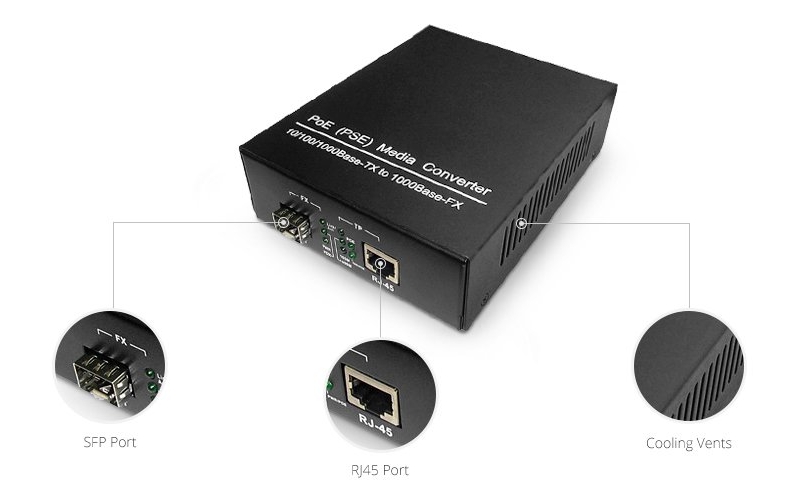It is often the case that media converter is deployed to connect copper to fiber, enabling network managers to overcome transmission distance limitation of traditional copper cabling. As one type of fiber media converter, the PoE media converter also works in those situations. How much do you know about the PoE media converter? How to use it? This article intends to explain the basis of the PoE media converter to help you learn more about it.
What Is a PoE Media Converter?
Traditionally, fiber media converters can only transmit data; while PoE media converter can not only help users to create an Ethernet-fiber link but also act as a power sourcing equipment (PSE) device to provide power to one or two powered devices (PD) over the UTP network cable.
By using the PoE media converter like the 10/100/1000M PoE media converter shown below, it provides a flexible and cost-effective solution for implementing and optimizing fiber links. In addition, PoE media converters like all the other Ethernet media converters, breaking the distance limitation of Ethernet cables, extend the network distance via fiber to remote PD such as the original VoIP phones, wireless access points, security cameras, and point-of-sale (POS) terminals in temperature control systems, and even in-flight entertainment systems.

How Does a PoE Media Converter Work?
There are two applications in which PoE media converter works: the PoE media converter only delivers data or it delivers both data and power. The picture below shows how the PoE media converter provides fiber-to-copper connections between the fiber switch and wireless access point and powers the access point simultaneously.
The fiber is run for a long distance to the PoE media converter located near a convenient AC or DC power source, where it does the fiber-to-copper conversion. At the other end of the UTP cable is the wireless access point, located up to 100 meters away from the PoE media converter.

How to Use a PoE Media Converter
There are three main applications of PoE media converters: fiber to IP cameras, fiber to wireless access points, and fiber to the desktop. Here we take fiber to IP cameras as an example to show the application of PoE media converter.
Before starting the deployment process, make sure you have access to the following devices: a Gigabit fiber switch, a 10/100/1000M PoE media converter, an IP camera, a network cable (like Cat5e/Cat6), a fiber patch cable (like OS2/OM4), and two SFP fiber optic transceivers.
Step 1: Insert an SFP module into the fiber port of the PoE media converter and an SFP module into the SFP port of the switch.
Step 2: Connect a fiber optic cable to the SFP module on the PoE media converter and the other end of the cable into the switch.
Step 3: Connect the RJ45 ports of the PoE media converter and the IP camera using a UTP Ethernet cable.
The video below will help you to get a better understanding of PoE media converters.
PoE Media Converter Buying Guide
How to choose the best PoE media converter that suits your network requirement? There are some points you should consider.
Data rate: the data rate of the PoE media converter is the first thing that should be considered. There are 10M, 100M, 1000M, 10/100M, and 10/100/1000M PoE media converters in the market which can be chosen as you need.
Port number and port type: in most cases, a PoE media converter features one fiber port and one RJ45 port, but there are still some PoE media converters that have multiple ports such as one or two fiber ports and four RJ45 ports.
Single mode or multimode: according to the transmission media, the PoE media converter can be divided into single mode converter and multimode converter, which will affect the transmission distance and the fiber optic transceivers that can be used.
Duplex mode: as some PoE media converters can only be used as full duplex but not half duplex, packet loss may occur when it is connected with the switch or hub that supports half duplex. So make sure it supports full duplex and half duplex.
Operating temperature: it should be noted especially when you need an industrial PoE media converter. Remember to check the operating temperature of the media converter to see if it can operate under extended temperature (−40 °C to 125 °C).
Standards: generally PoE media converter are IEEE802.3af, IEEE802.3at, or IEEE802.3bt compliant. Confirm that the PoE media converter you want supports these standards or there may be some compatibility problems.
No comments:
Post a Comment